SHARE
Did your doctor order an ” ANA ” test? Did the test come back positive? Of course, you are confused and concerned and would like to know more about this test. A positive ANA (antinuclear antibodies) test is one of my rheumatology office’s most common referral reasons. In this article, I will discuss the most common causes for a positive ANA test as well as:
- What is the ANA test, and why was it ordered?
- Is the ANA titer important?
- Is the ANA pattern suggestive of a specific disease?
- What are the most frequent causes of a positive ANA?
- What is the ANA test, and why was it ordered?
What is the ANA test?
ANA stands for “antinuclear antibodies.” As their name suggests, they are antibodies. Antibodies are proteins our immune system produces in response to a trigger, most of the time an infection. They are part of our body’s defense mechanism against foreign invaders. “Antinuclear antibodies” are a specific type of antibody directed against the nucleus of a cell. They can appear in your bloodstream when your immune system is fired-up to fight something foreign like viruses, bacteria, or a medication.
Sometimes, your immune system might “overreact,” and that will result in directing the “fight” against your body cells. In these situations, many organs can suffer when your body’s cells get attacked by your immune system. This is usually happening in autoimmune diseases.
Why was this test ordered?

Many patients are confused about why their doctor ordered this test. You must understand why this test was ordered. Therefore, when patients present with multiple complaints to the doctor like severe fatigue, unexplained rashes, muscle or joint pain, low grade, hair loss, enlarged lymph nodes, or brain fog, to name a few….and there is no other explanation, your doctor will order the ANA test to rule out an autoimmune disease. There are many autoimmune diseases, so this test is like an ENTRY tool or a screening tool for autoimmune illnesses when there is suspicion.
However, a positive test alone, without clinical symptoms, does not indicate that you have an autoimmune disease.
Let’s learn more….
Is the ANA titer important?
 Many times, a positive ANA screening test will also come with a “titer.” The titer of the test is essential. Naturally, you will ask, “What does the “titer” mean? Let me explain: The titer is the level to which the patient’s blood sample can be diluted and will still show positive ANA staining. That means that the higher the titer of the ANA test, the more autoantibodies are present in the sample.
Many times, a positive ANA screening test will also come with a “titer.” The titer of the test is essential. Naturally, you will ask, “What does the “titer” mean? Let me explain: The titer is the level to which the patient’s blood sample can be diluted and will still show positive ANA staining. That means that the higher the titer of the ANA test, the more autoantibodies are present in the sample.
Can high ANA titers be seen in healthy people?

Yes, a positive ANA can be seen in normal people. However, as you will see below, the prevalence of positive ANA without clinical significance will decrease significantly as the titer increases. For example, a positive ANA to a titer of
- 1:40 can be seen in up to 31%
- 1: 80 can be seen in 13%
- 1:160 can be seen in 5%
- 1:320 can be seen in 3% of healthy individuals without any sign of autoimmune disease.
I know that creates a lot of confusion among patients but also physicians. If you think about the prevalence of autoimmune diseases is approximately 1%, then you can imagine that this test can be falsely positive many times.
However, when these individuals carry an autoimmune disease like SLE or lupus, a positive ANA test, even at a low titer like 1:40 or 1:160, can be essential to detect these diseases.
Is the ANA pattern suggestive of a specific disease?
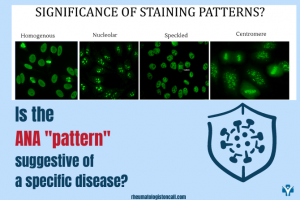
At times, laboratories testing ANA also report a “pattern”. The pattern refers to the distribution of staining produced by autoantibodies reacting with antigens in the cells. For this test, we use a specific type of cell called HEp-2. ANA pattern refers to the distribution of staining produced by autoantibodies reacting with antigens in these cells.
There are a few types of patterns reported :
- Homogeneous staining -when the entire nucleus is diffusely stained
- Speckled staining pattern when fine or coarse speckles are seen throughout the nucleus.
- Centromere pattern refers to the presence of 30 to 60 uniform speckles distributed throughout the nucleus; In mitotic cells, the speckles localize to the chromosomes at the metaphase plate.
- Nucleolar pattern refers to staining of the nucleolus only.

Is the pattern suggestive of an autoimmune disease diagnosis?
The answer is NO. The staining pattern is loosely associated with autoimmune diseases, but certain situations may be more frequently seen. It will direct our thoughts as rheumatologists toward possibilities.
For example, a homogeneous pattern can be seen in patients with lupus or drug-induced lupus, while a nucleolar pattern can be seen more in patients with scleroderma or myositis, while a speckled pattern can be seen in patients with Sjogren syndrome and a centromere pattern can be seen in limited forms of scleroderma-like CREST syndrome. In this movie, I discuss all these details and even more.
What are the most frequent diseases associated with a positive ANA?
Now I will discuss the most common five causes of a positive ANA that I see in my rheumatology clinic.

Autoimmune diseases
As we discussed, positive ANA can be seen in many autoimmune diseases:
- Connective tissue diseases that we in rheumatology treat, like Lupus, Sjogren, scleroderma, inflammatory myositis, vasculitis, and even rheumatoid arthritis.
- Autoimmune thyroid diseases like Hashimoto’s thyroiditis, Graves disease
- Autoimmune hepatitis, an autoimmune disease of the liver
- Primary Biliary cirrhosis, an autoimmune disease of the biliary ducts in the liver
Autoimmune diseases are the most frequent cause of a positive ANA. Even patients with Rheumatoid arthritis can have a positive ANA. Almost all patients with lupus have a positive ANA test.
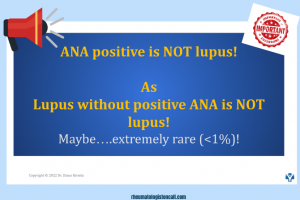
However, it is essential to remember that a positive ANA test does not mean you have Lupus. Patients with lupus have many other symptoms besides the fact that they have a positive ANA test. The positive test alone does not make the diagnosis of lupus. You need a rheumatology consultation in those cases with many other associated symptoms. As a specialist, I evaluate many patients based on clinical signs and symptoms, plus additional testing, I can also diagnose an autoimmune disease in my area of expertise.
Infections
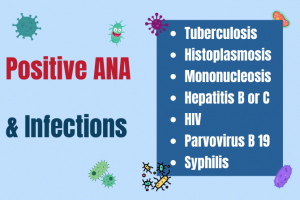
Another frequent cause for a positive ANA is exposure to chronic infections. When you suffer from chronic Infections, like tuberculosis, histoplasmosis, or even mononucleosis, your immune system is constantly activated by that virus or bacteria and will cause the formation of autoantibodies like ANA. A few other frequent infections that can cause a positive ANA tests are
- hepatitis B or C
- HIV
- parvovirus B 19
- syphilis
Medications
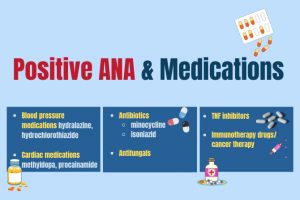
Medications are foreign substances for our bodies. As you suspect, our immune system, which is supposed to protect us from foreign invaders at some point, may see a particular medication as foreign and start producing antibodies against that.
Medications are notorious for causing positive ANA tests; some can even cause lupus, which we call drug-induced lupus. I will give you just a few examples :
- Blood pressure medications (Hydralazine, Hydrochlorothiazide)
- Other cardiac medications (Methyldopa, Procainamide.)
- Antibiotics (Minocycline, Isoniazid)
- Anti-fungals
- TNF- alpha inhibitors
- Immunotherapy drugs are used today in cancer therapy.
Cancers/malignancies
Rarely a positive ANA can be seen in patients with a history of cancers like lymphoma or other solid organ cancers. If you were exposed to radiation or radiation therapy, you might also have a positive ANA.
Normal People
As I mentioned, positive ANA tests can be seen in normal people. Usually, advancing in age will expose your immune system to many challenges, from infections to medication, radiation, or pollution, that can cause a positive ANA. However, if an autoimmune disease is suspected, there are other more specific tests that can be ordered.
Navigating the medical system these days can be very challenging. Your medical journey will be easier if you have the proper medical support, education, and a true advocate. Rheumatologist OnCall is a telemedicine company that offers support, diagnostic, and the most advanced therapeutic options for your disease affordably and transparently when you need it the most. No waiting time for months and no need to travel for tens or hundreds of miles. You can have a medical appointment from the comfort of your home.
Remember that if you have many symptoms and a higher ANA titer, you must be seen by a rheumatologist. It is easy now to schedule an appointment with a rheumatologist and start your journey toward a better life, and better education about understanding your tests and symptoms.
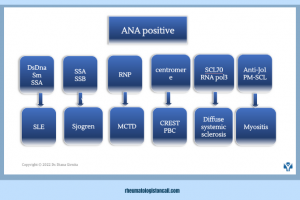

Contributors to this article
Diana Girnita MD, PhD and Ana Girnita














